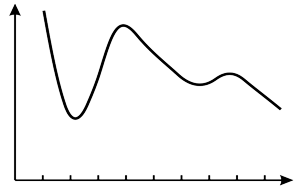Blurred relaxation spectra in dielectric materials
DOI:
https://doi.org/10.3103/S0735272722050016Abstract
This paper presents a substantiation of relaxation model of dielectric spectra that is based on Debye’s assumption about the dispersion of dielectric permittivity. According to this assumption the electric polarization of polar complexes is lagging at high frequencies of electric field that results in the reduction of dielectric permittivity, while the dielectric loss coefficient achieves its maximum. The paper considers an elementary model of dielectric relaxation. It has been shown that in processing of data of dielectric dispersion under an assumption of single time of relaxation, the accuracy of measurements should be very high. The relaxation spectrum of permittivity dispersion is found to be low-sensitive to the distribution or to interaction of relaxation oscillators. The existing approaches are described for explaining the blurring of dielectric spectra. They include empirical models of Cole–Cole, Fuoss–Kirkwood, Cole–Davidson, and Havriliak–Negami. The paper presents the analysis of the specified models and provides their advantages and disadvantages. A new model (non-empirical) approach is proposed for describing the extended dielectric relaxation spectra. The new approach is applied for materials with uniform and Gaussian distribution of frequencies of relaxation oscillators.
References
- T. Teranishi, “Broadband spectroscopy of dielectrics and oxygen-ion conductors,” J. Ceram. Soc. Japan, vol. 125, no. 7, pp. 547–551, 2017, doi: https://doi.org/10.2109/jcersj2.17083.
- Y. Poplavko, Dielectric Spectroscopy of Electronic Materials: Applied Physics of Dielectrics. Woodhead Publishing, 2021, uri: https://www.elsevier.com/books/dielectric-spectroscopy-of-electronic-materials/poplavko/978-0-12-823518-8.
- Y. Poplavko, Electronic Materials: Principles and Applied Science. Elsevier, 2018, uri: https://www.elsevier.com/books/electronic-materials/poplavko/978-0-12-815255-3.
- X. Li, M. Ahmadi, L. Collins, S. V. Kalinin, “Deconvolving distribution of relaxation times, resistances and inductance from electrochemical impedance spectroscopy via statistical model selection: Exploiting structural-sparsity regularization and data-driven parameter tuning,” Electrochim. Acta, vol. 313, pp. 570–583, 2019, doi: https://doi.org/10.1016/j.electacta.2019.05.010.
- L. E. Helseth, “Modelling supercapacitors using a dynamic equivalent circuit with a distribution of relaxation times,” J. Energy Storage, vol. 25, p. 100912, 2019, doi: https://doi.org/10.1016/j.est.2019.100912.
- H. Wang, L. Yang, X. Zhang, M. H. Ang, “Permittivity, loss factor and Cole-Cole model of acrylic materials for dielectric elastomers,” Results Phys., vol. 29, p. 104781, 2021, doi: https://doi.org/10.1016/j.rinp.2021.104781.
- Z. Li, H. Y. K. Lau, X. Chen, “Effects of variation of permittivity and the actuating voltage on the dynamic response of dielectric elastomer actuator,” in Electroactive Polymer Actuators and Devices (EAPAD) XXI, 2019, p. 19, doi: https://doi.org/10.1117/12.2514056.
- D. Yang et al., “High efficiency planar-type perovskite solar cells with negligible hysteresis using EDTA-complexed SnO2,” Nat. Commun., vol. 9, no. 1, p. 3239, 2018, doi: https://doi.org/10.1038/s41467-018-05760-x.
- K. S. Cole, R. H. Cole, “Dispersion and absorption in dielectrics I. Alternating current characteristics,” J. Chem. Phys., vol. 9, no. 4, pp. 341–351, 1941, doi: https://doi.org/10.1063/1.1750906.
- C. Zou, L. Zhang, X. Hu, Z. Wang, T. Wik, M. Pecht, “A review of fractional-order techniques applied to lithium-ion batteries, lead-acid batteries, and supercapacitors,” J. Power Sources, vol. 390, pp. 286–296, 2018, doi: https://doi.org/10.1016/j.jpowsour.2018.04.033.
- R. M. Fuoss, J. G. Kirkwood, “Electrical properties of solids. VIII. Dipole moments in polyvinyl chloride-diphenyl systems,” J. Am. Chem. Soc., vol. 63, no. 2, pp. 385–394, 1941, doi: https://doi.org/10.1021/ja01847a013.
- D. W. Davidson, R. H. Cole, “Dielectric relaxation in glycerol, propylene glycol, and n‐propanol,” J. Chem. Phys., vol. 19, no. 12, pp. 1484–1490, 1951, doi: https://doi.org/10.1063/1.1748105.
- S. Havriliak, S. Negami, “A complex plane representation of dielectric and mechanical relaxation processes in some polymers,” Polymer, vol. 8, pp. 161–210, 1967, doi: https://doi.org/10.1016/0032-3861(67)90021-3.
- A. A. Khamzin, “Trap-controlled fractal diffusion model of the Havriliak-Negami dielectric relaxation,” J. Non-Crystalline Solids, vol. 524, p. 119636, 2019, doi: https://doi.org/10.1016/j.jnoncrysol.2019.119636.
- H. Frohlich, Theory of Dielectrics: Dielectric Constant and Dielectric Loss. Oxford at the Clarendon Press, 1958, uri: https://www.amazon.com/Theory-Dielectrics-Dielectric-Monographs-Chemistry-dp-0198513038/dp/0198513038/ref=dp_ob_title_bk.
- F. Kremer, A. Schönhals, Eds., Broadband Dielectric Spectroscopy. Berlin, Heidelberg: Springer Berlin Heidelberg, 2003, doi: https://doi.org/10.1007/978-3-642-56120-7.
- A. Prokopchuk, I. Zozulia, Y. Didenko, D. Tatarchuk, H. Heuer, Y. Poplavko, “Dielectric permittivity model for polymer–filler composite materials by the example of Ni- and graphite-filled composites for high-frequency absorbing coatings,” Coatings, vol. 11, no. 2, p. 172, 2021, doi: https://doi.org/10.3390/coatings11020172.


